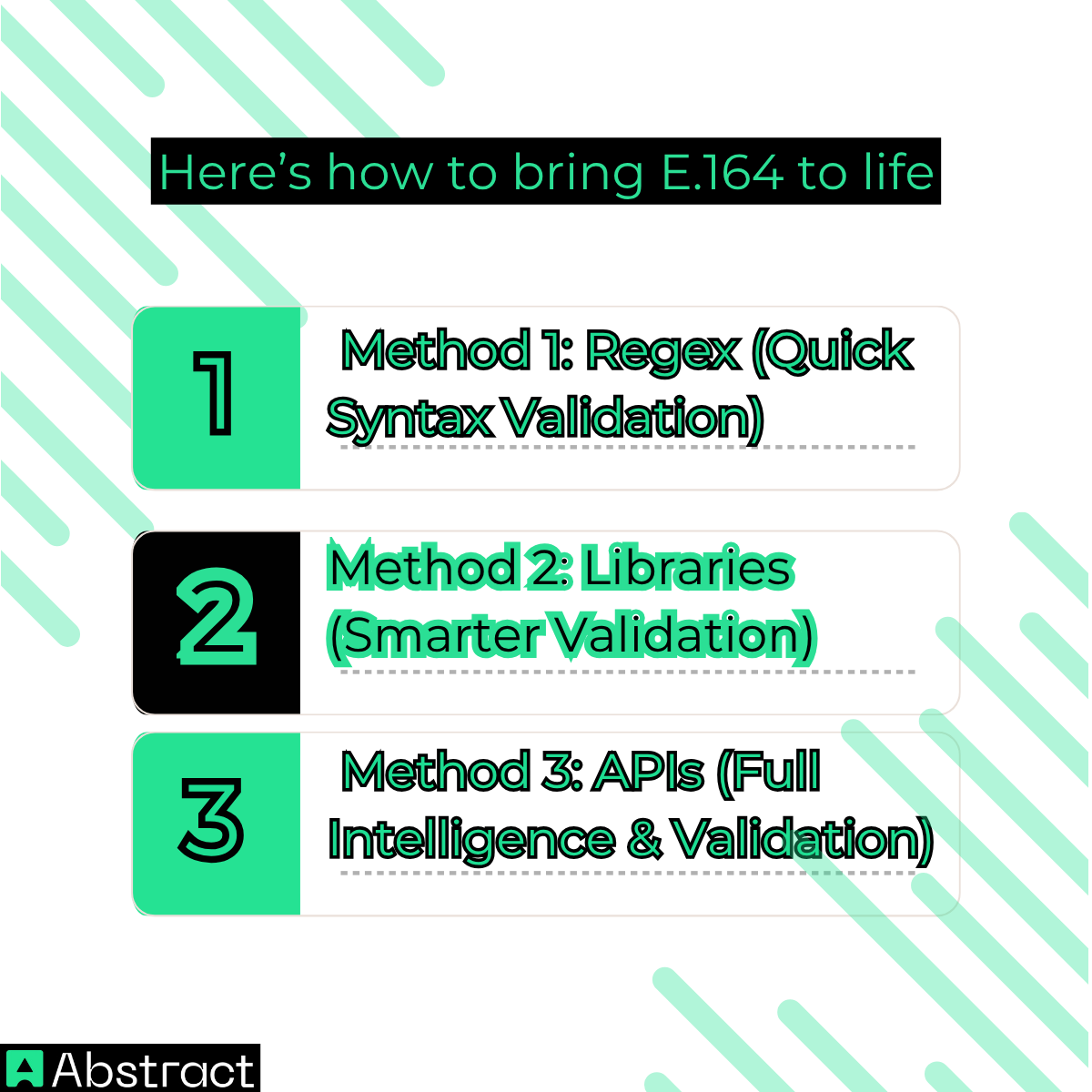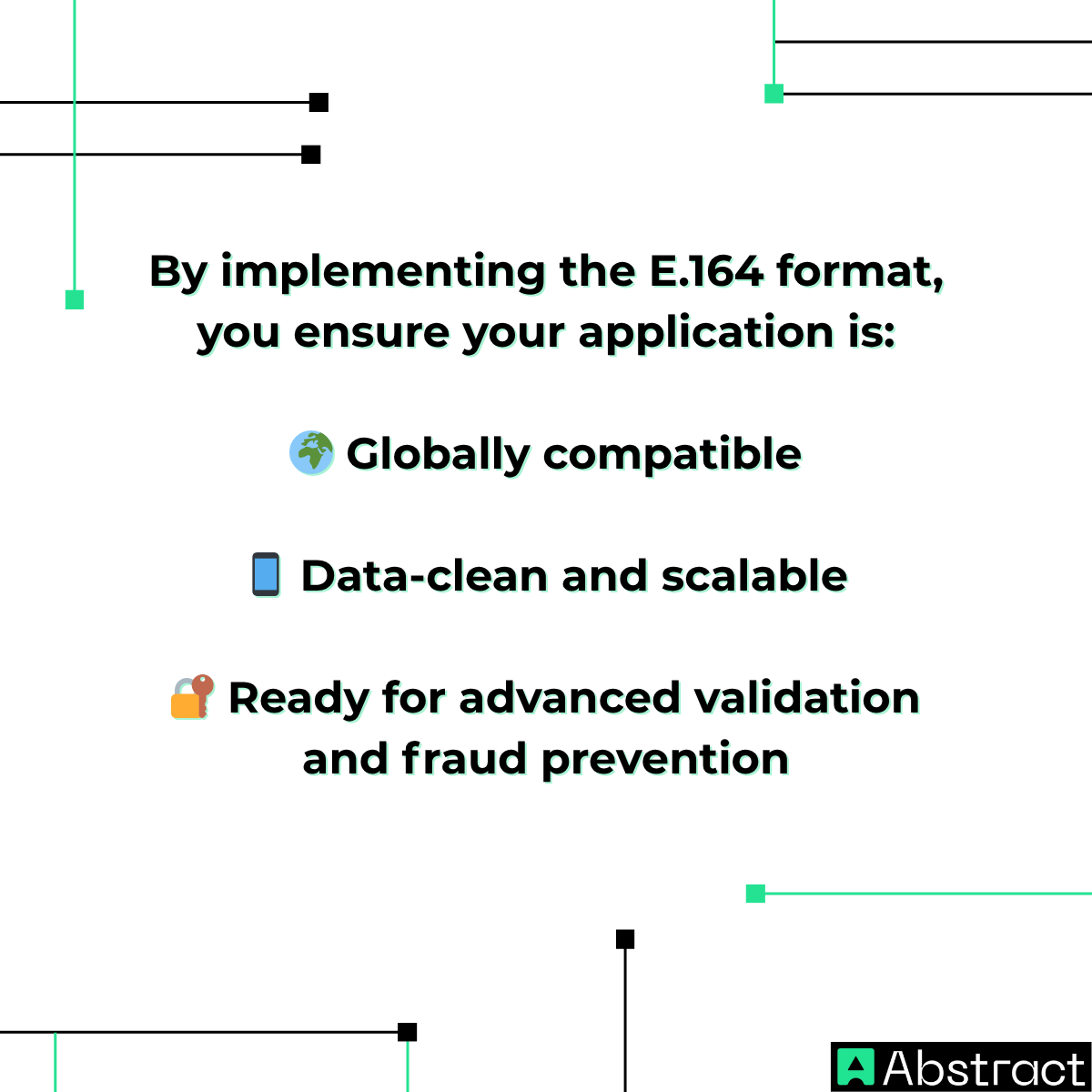Deconstructing the E.164 Standard – The Anatomy of a Global Number
The E.164 standard, established by the International Telecommunication Union (ITU-T), defines the structure for international phone numbers. Its goal: ensure every phone number can be routed anywhere in the world without confusion.
🧩 Core Components and Rules
Each valid E.164 number includes three key parts:
Two inviolable rules:

➕ The Role of the Plus Sign
That small + is more than cosmetic — it’s critical. It tells devices and systems to use the international dialing prefix automatically, ensuring consistent interpretation worldwide.
🌍 Examples Across Countries
The Developer’s Bottom Line – Why E.164 is Non-Negotiable
If your app stores or transmits phone numbers, E.164 compliance isn’t optional — it’s the difference between working and breaking.
⚙️ Ensuring API Reliability and Functionality
Most telecom and verification APIs — including Twilio, Vonage, and AbstractAPI’s Phone Validation API
— require E.164-formatted input.
🚫 Malformed numbers cause:
- Failed API calls
- Undelivered messages
- Invalid verification links
Using E.164 guarantees seamless communication between systems and providers.
🧮 Maintaining Database Integrity and CRM Synchronization
E.164 acts as the canonical format across all systems, keeping data clean and consistent.
Benefits include:
- Eliminating duplicates in CRM platforms
- Enabling smooth synchronization across services
- Ensuring data hygiene and long-term integrity
🌐 Enabling Global Consistency and Scalability
By adopting E.164, developers can support international users without writing endless country-specific parsing logic. One format = global compatibility 🌎.
🔒 A Prerequisite for Fraud Prevention and Intelligence
E.164 isn’t just about formatting — it’s about trust. Once standardized, phone numbers can be analyzed for:
- Line type (mobile, landline, VoIP)
- Carrier and region
- Risk level or activity status
This is where AbstractAPI’s Phone Validation API truly shines — providing verified, enriched phone data that strengthens authentication flows and fraud detection pipelines.
The Implementation Playbook – Validating and Normalizing Phone Numbers
Here’s how to bring E.164 to life — from basic checks to full validation.

🧠 Method 1: Regex (Quick Syntax Validation)
Use regex for a lightweight first-pass check:
import re
def is_e164(number):
return bool(re.match(r"^\+[1-9]\d{1,14}$", number))
✅ Fast and easy
⚠️ Doesn’t confirm if the number is real or active
🧰 Method 2: Libraries (Smarter Validation)
Tools like Google’s libphonenumber add contextual awareness — identifying the correct format and country.
Example in JavaScript:
import { parsePhoneNumberFromString } from 'libphonenumber-js'
const number = parsePhoneNumberFromString('07986 123456', 'GB')
console.log(number.format('E.164')) // +447986123456
✅ Validates structure
⚠️ Lacks metadata like carrier or risk score
🚀 Method 3: APIs (Full Intelligence & Validation)
For production systems, APIs offer accuracy and insights that regex or libraries can’t.
AbstractAPI’s Phone Validation API verifies not just structure but also authenticity and metadata:
{
"valid": true,
"format": { "e164": "+14155550123" },
"type": "mobile",
"carrier": "AT&T",
"country": "US"
}
It’s the easiest way to integrate real-time phone intelligence into your app or CRM.
🧩 The Normalization Logic
Behind the automation, here’s what happens when you normalize a number manually:
- Strip spaces, dashes, parentheses
- Remove local prefixes or zeros
- Prepend country code and +
That’s exactly what libraries and APIs automate for you — saving time and avoiding costly formatting errors.
Advanced Insights – E.164 Beyond the Basics
🗂️ The Five E.164 Number Categories
According to ITU-T, E.164 defines several categories:
- Geographic areas
- Global services (e.g., toll-free numbers)
- Networks (mobile and fixed-line)
- Groups of countries with shared numbering plans
- Trials and reserved uses
🌐 ENUM – Where E.164 Meets the Internet
The E.164 Number Mapping (ENUM) system bridges traditional phone networks (PSTN) and VoIP. It maps phone numbers to internet-based addresses using DNS, allowing calls to be routed as SIP URIs.
In short: E.164 is not just a relic of telecom — it’s the backbone of modern communication systems.
✅ Conclusion – Standardize Your Phone Numbers, Strengthen Your Application
Unstandardized phone numbers cause more than messy databases — they can break APIs, disrupt communications, and compromise trust.

Start with the AbstractAPI Phone Validation API to instantly format, validate, and enrich your user phone data — and transform every phone number from chaos into clarity. ✨



